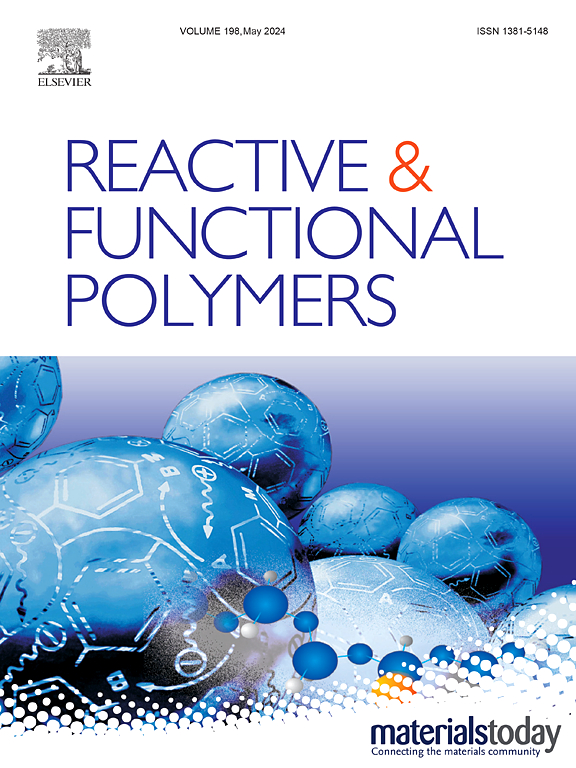New injectable dressing: A green synthesis-based composite hydrogel (NaCMC/CA/BG) with high antibacterial activity
IF 5.1
3区 工程技术
Q1 CHEMISTRY, APPLIED
引用次数: 0
Abstract
Infections caused by antibiotic-resistant bacteria pose a serious threat to modern healthcare. A potential solution to prevent this issue is the development of new composite systems with antibacterial properties. In this study, a series of composite hydrogels based on sodium carboxymethyl cellulose (NaCMC), citric acid (CA), and bioglass (BG) were prepared using an eco-friendly synthesis method. The synthetic component (BG) varied in the hydrogels and was analyzed separately by XRD and chemical durability tests. Various techniques, such as SEM-EDX, FTIR, and rheological measurements were employed for the structural characterization of the hydrogels. The antibacterial efficiency against six bacterial strains was performed by an adapted disk diffusion technique. The cross-linking of hydrogels with CA, as well as the presence of BG in composite hydrogels, was demonstrated by the FTIR spectra. Rheological measurements indicated the non-Newtonian, pseudoplastic, and thixotropic character of the composite hydrogels, suggesting their favorable injectable performance. SEM analysis confirmed the porous, homogeneous, and 3D structure of the hydrogels, along with their absorption properties. Only five of six bacterial strains were susceptible to the NaCMC/CA/BG hydrogels and positive control (GEN). The results showed large and clear zones of inhibition exhibited by composite hydrogels confirming their high antibacterial character. However, there were no significant differences between the blank sample (NaCMC/CA) and BG-containing hydrogels (NaCMC/CA/BG) after 24 h. Together, these results suggest that the NaCMC/CA/BG-based hydrogel can be a promising candidate for drug delivery due to its high susceptibility to antibacterial activity.

新型注射敷料:一种绿色合成复合水凝胶(NaCMC/CA/BG),具有较高的抗菌活性
耐抗生素细菌引起的感染对现代医疗保健构成严重威胁。防止这一问题的潜在解决方案是开发具有抗菌性能的新型复合系统。本研究以羧甲基纤维素钠(NaCMC)、柠檬酸(CA)和生物玻璃(BG)为原料,采用环保合成方法制备了一系列复合水凝胶。合成组分(BG)在水凝胶中变化,分别通过XRD和化学耐久性试验进行了分析。各种技术,如SEM-EDX, FTIR和流变学测量被用于水凝胶的结构表征。采用圆盘扩散法对6株细菌进行了抑菌效果试验。FTIR光谱证实了水凝胶与CA的交联,以及复合水凝胶中BG的存在。流变学测试表明,复合水凝胶具有非牛顿、假塑性和触变特性,表明其具有良好的注射性能。扫描电镜分析证实了水凝胶的多孔性、均匀性和三维结构,以及它们的吸收特性。6株细菌中仅有5株对NaCMC/CA/BG水凝胶和阳性对照(GEN)敏感。结果表明,复合水凝胶具有明显的抑菌作用,具有良好的抑菌性能。然而,空白样品(NaCMC/CA)和含BG的水凝胶(NaCMC/CA/BG)在24 h后没有显著差异。这些结果表明,基于NaCMC/CA/BG的水凝胶由于其高度的抗菌活性,可能是一个有希望的药物递送候选物。
本文章由计算机程序翻译,如有差异,请以英文原文为准。
求助全文
约1分钟内获得全文
求助全文
来源期刊

Reactive & Functional Polymers
工程技术-高分子科学
CiteScore
8.90
自引率
5.90%
发文量
259
审稿时长
27 days
期刊介绍:
Reactive & Functional Polymers provides a forum to disseminate original ideas, concepts and developments in the science and technology of polymers with functional groups, which impart specific chemical reactivity or physical, chemical, structural, biological, and pharmacological functionality. The scope covers organic polymers, acting for instance as reagents, catalysts, templates, ion-exchangers, selective sorbents, chelating or antimicrobial agents, drug carriers, sensors, membranes, and hydrogels. This also includes reactive cross-linkable prepolymers and high-performance thermosetting polymers, natural or degradable polymers, conducting polymers, and porous polymers.
Original research articles must contain thorough molecular and material characterization data on synthesis of the above polymers in combination with their applications. Applications include but are not limited to catalysis, water or effluent treatment, separations and recovery, electronics and information storage, energy conversion, encapsulation, or adhesion.
 求助内容:
求助内容: 应助结果提醒方式:
应助结果提醒方式:


